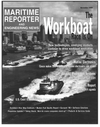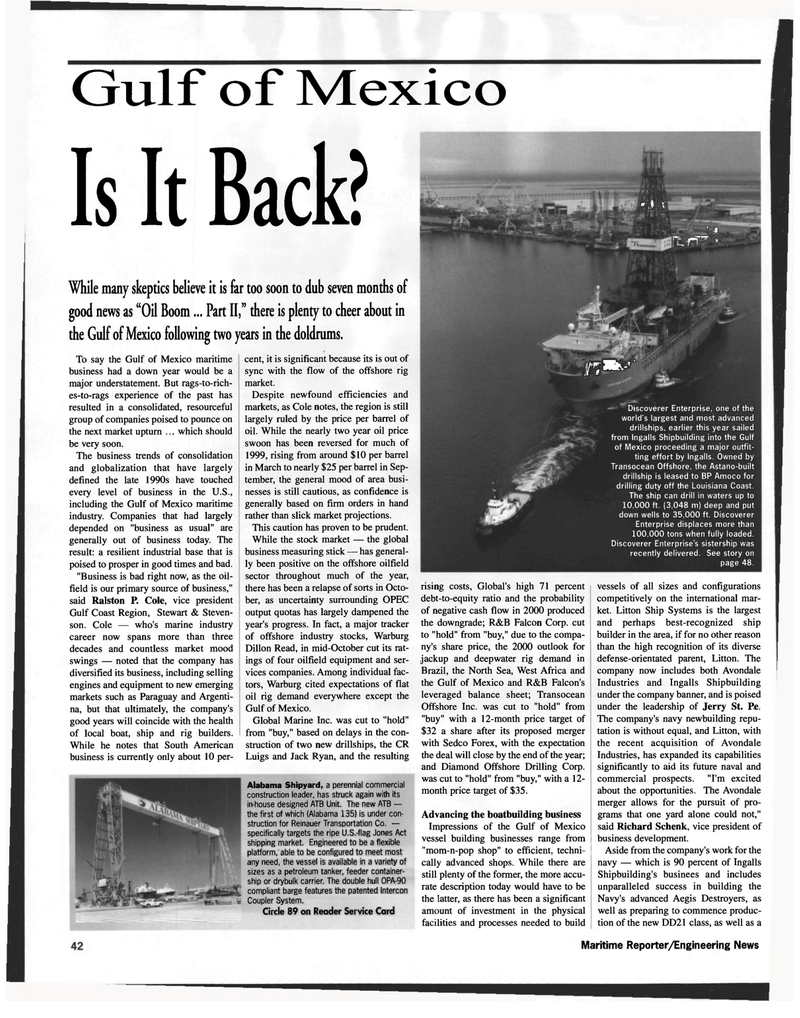
Page 42: of Maritime Reporter Magazine (November 1999)
Read this page in Pdf, Flash or Html5 edition of November 1999 Maritime Reporter Magazine
Gulf of Mexico Is It Back? While many skeptics believe it is far too soon to dub seven months of good news as "Oil Boom... Part II," there is plenty to cheer about in the Gulf of Mexico following two years in the doldrums. '} V ? 4 rc'fT^ * II ?Mtss-Discoverer Enterprise, one of the world's largest and most advanced drillships. earlier this year sailed from Ingalls Shipbuilding into the Gulf of Mexico proceeding a major outfit-ting effort by Ingalls. Owned by Transocean Offshore, the Astano-built drillship is leased to BP Amoco for drilling duty off the Louisiana Coast. The ship can drill in waters up to 10,000 ft. (3,048 m) deep and put down wells to 35,000 ft. Discoverer Enterprise displaces more than 100.000 tons when fully loaded. Discoverer Enterprise's sistership was recently delivered. See story on page 48. To say the Gulf of Mexico maritime business had a down year would be a major understatement. But rags-to-rich-es-to-rags experience of the past has resulted in a consolidated, resourceful group of companies poised to pounce on the next market upturn ... which should be very soon. The business trends of consolidation and globalization that have largely defined the late 1990s have touched every level of business in the U.S., including the Gulf of Mexico maritime industry. Companies that had largely depended on "business as usual" are generally out of business today. The result: a resilient industrial base that is poised to prosper in good times and bad. "Business is bad right now, as the oil-field is our primary source of business," said Ralston P. Cole, vice president Gulf Coast Region, Stewart & Steven-son. Cole ? who's marine industry career now spans more than three decades and countless market mood swings ? noted that the company has diversified its business, including selling engines and equipment to new emerging markets such as Paraguay and Argenti-na, but that ultimately, the company's good years will coincide with the health of local boat, ship and rig builders. While he notes that South American business is currently only about 10 per-cent, it is significant because its is out of sync with the flow of the offshore rig market. Despite newfound efficiencies and markets, as Cole notes, the region is still largely ruled by the price per barrel of oil. While the nearly two year oil price swoon has been reversed for much of 1999, rising from around $10 per barrel in March to nearly $25 per barrel in Sep-tember, the general mood of area busi-nesses is still cautious, as confidence is generally based on firm orders in hand rather than slick market projections. This caution has proven to be prudent. While the stock market ? the global business measuring stick ? has general-ly been positive on the offshore oilfield sector throughout much of the year, there has been a relapse of sorts in Octo-ber, as uncertainty surrounding OPEC output quotas has largely dampened the year's progress. In fact, a major tracker of offshore industry stocks, Warburg Dillon Read, in mid-October cut its rat-ings of four oilfield equipment and ser-vices companies. Among individual fac-tors, Warburg cited expectations of flat oil rig demand everywhere except the Gulf of Mexico. Global Marine Inc. was cut to "hold" from "buy," based on delays in the con-struction of two new drillships, the CR Luigs and Jack Ryan, and the resulting rising costs, Global's high 71 percent debt-to-equity ratio and the probability of negative cash flow in 2000 produced the downgrade; R&B Falcon Corp. cut to "hold" from "buy," due to the compa-ny's share price, the 2000 outlook for jackup and deep water rig demand in Brazil, the North Sea, West Africa and the Gulf of Mexico and R&B Falcon's leveraged balance sheet; Transocean Offshore Inc. was cut to "hold" from "buy" with a 12-month price target of $32 a share after its proposed merger with Sedco Forex, with the expectation the deal will close by the end of the year; and Diamond Offshore Drilling Corp. was cut to "hold" from "buy," with a 12-month price target of $35. Advancing the boatbuilding business Impressions of the Gulf of Mexico vessel building businesses range from "mom-n-pop shop" to efficient, techni-cally advanced shops. While there are still plenty of the former, the more accu-rate description today would have to be the latter, as there has been a significant amount of investment in the physical facilities and processes needed to build vessels of all sizes and configurations competitively on the international mar-ket. Litton Ship Systems is the largest and perhaps best-recognized ship builder in the area, if for no other reason than the high recognition of its diverse defense-orientated parent, Litton. The company now includes both Avondale Industries and Ingalls Shipbuilding under the company banner, and is poised under the leadership of Jerry St. Pe. The company's navy newbuilding repu-tation is without equal, and Litton, with the recent acquisition of Avondale Industries, has expanded its capabilities significantly to aid its future naval and commercial prospects. "I'm excited about the opportunities. The Avondale merger allows for the pursuit of pro-grams that one yard alone could not," said Richard Schenk, vice president of business development. Aside from the company's work for the navy ? which is 90 percent of Ingalls Shipbuilding's businees and includes unparalleled success in building the Navy's advanced Aegis Destroyers, as well as preparing to commence produc-tion of the new DD21 class, as well as a Alabama Shipyard, a perennial commercial construction leader, has struck again with its in-house designed ATB Unit. The new ATB ? the first of which (Alabama 135) is under con-struction for Reinauer Transportation Co. ? specifically targets the ripe U.S.-flag Jones Act shipping market. Engineered to be a flexible platform/able to be configured to meet most any need, the vessel is available in a variety of sizes as a petroleum tanker, feeder container-ship or drybulk carrier. The double hull OPA-90 compliant barge features the patented Intercon Coupler System. Circle 89 on Reader Service Card 56D Maritime Reporter/Engineering News

 41
41

 43
43
